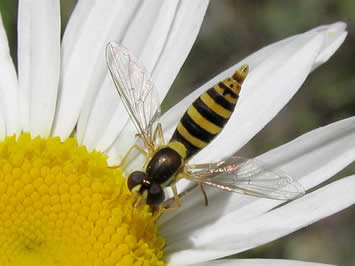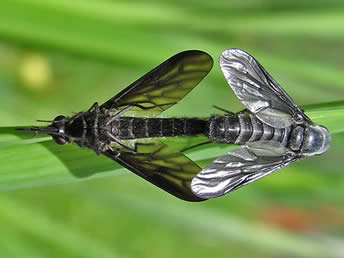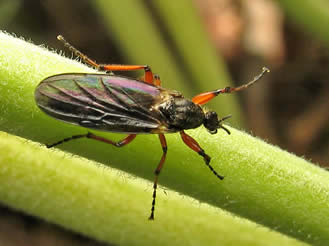

THE TRUE FLIES (DIPTERA) OF
BRITISH COLUMBIA

Flower Fly (female) (Sphaerophoria sp.), photo by Werner Eigelsreiter
by
R. A. Cannings and G. G. E. Scudder
Copyright © 2005 - All rights reserved
Extracted from the forthcoming publication The Insect Families of British Columbia.
Introduction (draft only)
Flying insects have long been called "flies" of various sorts - dragonflies, mayflies, fireflies, caddisflies, butterflies and so on. But these all belong to different orders of insects, only distantly related to each other. In entomology, none of these are flies proper, insects of the Order Diptera, which are often referred to as "true flies" or "two-winged flies" because they never have more than one pair of wings, those on the middle segment of the thorax. Some insects in other orders have lost a pair of wings, sometimes the front pair, sometimes the back one -- but none of these, except some male scale insects, have the hind wings reduced to halter-like structures. We follow convention in writing the English names of Diptera as two words (crane fly, house fly) and those called flies in other orders as a single word (dragonfly, stonefly).
Flies are minute to large insects (about 0.5 to 60 mm long), extremely variable in form and colour, but are mostly rather soft bodied, flying forms. The compound eyes are usually large, often occupying most of the head. They may meet on the top of the head or may be well separated; often, in the same species, the males show the former condition, the females the latter one. Typically, three ocelli occur, but these are reduced or lost in many groups, such as the aquatic families of Nematocera. The antennae are extremely variable in form and consist of three to forty segments. The simplest, basic nematoceran type is thread-like and 16-segmented; the basic number of segments in the Brachycera is eight, but is reduced to four in the higher Diptera. In most of the latter flies, the third segment is enlarged and the more apical segments are reduced to an appendage -- called a stylus when rigid and an arista when bristle-like. Mouthparts are modified and combined into a sucking proboscis, which is highly variable in structure. The ancestral condition is evidently the piercing and sucking type proboscis, more modified proboscis’ forms rasp or sponge fluids. Some species have non-functional mouthparts. No flies bite in the true sense of cutting food between mandibles; biting flies pierce the skin of their victims and suck or lap up blood.

Black Bee Flies (mating), photo by Werner Eigelsreiter
Diptera are primarily aerial insects and the mesothorax, which bears the only pair of wings, has come to dominate the thorax -- the prothorax and metathorax are greatly reduced. The legs are normally rather simple and are used primarily for perching; in some groups they are modified for prey capture or for signaling during courtship. The tarsi are nearly always 5-segmented. The functional wings are membranous and their pattern of veins is critical in fly classification and identification. During the evolution of flies there has been a trend towards a reduction in veins, especially in the rear half of the wing – changes that evidently relate to improvements in two-winged flight. The hind wings, present in most other insects, are reduced in Diptera to small, club-like organs, called halteres, used for stabilizing flight.
Flies are holometabolous insects and the larvae typically live completely different lives than the adult insects do. The larvae eat to grow and to provide reserves for adult activity; the adult is primarily a reproductive and dispersal stage. The larvae never have jointed thoracic legs, but sometimes have fleshy prolegs or pseudopods that allow them to move by pushing against surfaces around them. Nematoceran species usually have a complete, well-sclerotized head capsule, but this is reduced drastically in the maggots of higher Diptera to an internal skeleton supporting the hooked mandibles and pharynx. The pupa is usually immobile, although those of some aquatic Nematocera (e.g. mosquitoes) actively swim. In some flies, larvae are deposited after they hatch inside the female; in others, notably the bird and bat parasites in the families Hippoboscidae, Nycteribiidae and Streblidae (but also in the tsetse flies (Glossina)), there are no free-living larvae -- the larvae are fed glandular secretions inside the adult female and are dropped only when ready to pupate. At the other extreme, the larvae of some gall midges (Cecidomyiidae) give birth to other larvae (paedogenesis).

March Fly (Bibio species), photo by Werner Eigelsreiter
The Order Diptera is usually divided into two suborders, the Nematocera and the Brachycera. Among the main differences are the structure of the antennae, maxillary palps and larval mandibles. The basic number of segments in the antennal flagellum of the most ancestral Brachycera is eight. Most nematocerans have more than eight segments in the flagellum and having fewer is considered a secondary reduction. All Brachycera have two or fewer segments in the maxillary palp while the basic number in the Nematocera is five. The mandibles of brachyceran larvae lie parallel and move vertically; those of the Nematocera are opposable and move horizontally. The Brachycera are further divided by major evolutionary steps such as the development of a puparium (pupation within the hardened final larval skin) and the subsequent evolution of an eversible sac (ptilinum), which is extruded through sutures above and beside the antennae and forces the top of the puparium open, allowing the adult fly to emerge.
About 150,000 species of living Diptera have been described in approximately 10,000 genera and 150 families; this is about 14% of the world’s known insect fauna. The true number of fly species is probably many times more than this. Many species of flies are cool or cold adapted and the relative abundance of Diptera in the total insect fauna is higher in northern countries such as Canada than in the world as a whole. In high arctic sites, the number of fly species is greater than that of all other insects.
The astounding success of flies is owing to their great versatility in the exploitation of habitats and their ability to utilize every possible sort of food. The larvae of the earliest flies probably fed on damp, decaying plant material, a ubiquitous food source over much of the Earth. Flies then colonized both wetter and drier habitats, leading to life in aquatic and terrestrial environments. Many are predators, parasites and parasitoids, feeding on everything from microscopic animals to mammals; many eat decaying organic matter and plant material. Unlike the adult stages of many beetles and bugs, adult Diptera have not successfully colonized underwater habitats, but many aquatic or semiaquatic larvae are common in fly families. They live from the intertidal waters of the ocean shores to the salt-encrusted margins of desert alkaline lakes, from rushing glacial torrents to the bottom of deep lakes. Many of these larvae, such as those of mosquitoes, horse flies and soldier flies, breathe atmospheric air through open spiracles and must come to the surface periodically. Others, such as chironomid midges and black flies, take oxygen from the water through their integument. Still others live in wet mud or sand or under thin films of water. Those groups, mostly in the higher Diptera, that evolved towards drier habitats live in soil and sand, in leaf litter, under bark, in wood and fungi, in decomposing material or inside growing plant tissues such as roots, stems, fruits and leaves. Some live as ectoparasites on the skin of vertebrates. Secondarily, many returned to a more fluid habitat, such as those in the syrphid, subfamily Eristalinae, where rat-tailed maggots live in semi-liquid, decaying material; in the Ephydridae, where larvae of one species lives in crude petroleum; and in the Oestridae that are obligate parasites inside the bodies of mammals.
Adult flies feed on a wide variety of substances although some have non-functional mouthparts and do not feed as adults. Most eat liquid food: water; decomposing organic matter; animal and plant secretions such as insect honeydew and flower nectar; animal tissue fluids, including vertebrate blood; soluble solids liquefied by saliva.
Flies are ubiquitous and are abundant in individuals as well as in species number. They are important food for other animals. Many are parasitic or predatory on other insects and help keep their populations under control. Some herbivorous flies have been successfully used to control weeds. Many are probably important pollinators of plants; certainly a few important crops such as cacao and rubber depend on pollination by ceratopogonids. Many are invaluable as scavengers and are vital in aiding the never-ending decomposition of plant and animal material. The flies of Drosophila, readily raised in the laboratory and sporting huge salivary chromosomes, provided much of our early understanding of genetics. On the negative side of the ledger, flies are famous. They are far and away the most important insects vectoring diseases in humans and domesticated animals. Blood-sucking flies transmit many diseases, including malaria, yellow fever, filariasis, leishmaniasis, and sleeping sickness. Some flies are important pests of crops -- tephritid fruit flies are serious pests of fruit; leaf miners, stem borers and other flies destroy our garden plants and crops; others carry plant diseases. Swarming flies can be a nuisance just because they are so numerous.
For a full description of the Order Diptera and Families
of Diptera click here
Keys to Families of Diptera in BC
Checklist of the Diptera Families of British Columbia
References
Cole, F.R. 1969. The flies of western North America. University of California Press, Berkeley, CA.
McAlpine, J.F., B.V. Peterson, G.E. Shewell, H.J. Teskey, J.R. Vockeroth and D.M. Wood. 1981. Manual of Nearctic Diptera. Volume 1. Agriculture Canada Monograph No. 27. Research Branch, Agriculture Canada, Ottawa, ON.
McAlpine, J.F., B.V. Peterson, G.E. Shewell, H.J. Teskey, J.R. Vockeroth and D.M. Wood. 1987. Manual of Nearctic Diptera. Volume 2. Agriculture Canada Monograph No. 28. Research Branch, Agriculture Canada, Ottawa, ON.
McAlpine, J.F. and D.M. Wood. 1989. Manual of Nearctic Diptera. Volume 3. Agriculture Canada Monograph No. 32. Research Branch, Agriculture Canada, Ottawa, ON.
Oldroyd, H. 1964. The natural history of flies. W.W. Norton and Company. New York, NY.
Yeates, D.K. and B.M. Wiegmann (eds.). 2005. The Evolutionary Biology of Flies. Columbia University Press, New York, NY.
Structure of Diptera
When describing fly structure, we use the terminology of McAlpine (1981).
Classification
The higher classification of the Diptera is in flux. That used here is from Wood and Borkent (1989) for the suborder Nematocera (lower Diptera) and from Yeates and Weigmann (2005) for the suborder Brachycera (higher Diptera). While Yeates and Weigmann (2005) indicate that the suborder Nematocera is a paraphyletic grouping, the exact relationship of the lower fly families is not certain. Thus we have deferred to the older higher classification of Wood and Borkent (1989) for this group. This amalgam of higher classification schemes is also being followed for the Manual of Central American Diptera, which is being developed (B.V. Brown, pers. com.).
There is also some controversy as to whether some of the families are monophyletic. In such cases we have followed, in large part, the family classification presented in the Manual of Nearctic Diptera to allow for the use of its generic level keys, but noted the controversy in the discussion of the respective families. As well, we have used some traditional artificial higher groupings, such as Aschiza, in the development of the family keys to make the keys more user-friendly. This is because many of the characters that indicate the true evolutionary relationships of some fly families are genitalic and/or molecular, both of which would make a key unnecessarily awkward to use.
References
McAlpine, J.F. 1981. Morphology and terminology - adults. pp. 9-63 In McAlpine, J.F., Peterson, B.V., Shewell, G.E., Teskey, H.J., Vockeroth, J.R., and Wood, D.M. (Eds): Manual of Nearctic Diptera. Volume 1. Research Branch Agriculture Canada Monograph 27: 1-674.
Wood, D.M., and Borkent, A. 1989. Phylogeny and classification of the Nematocera. pp. 1333-1370 In McAlpine, J.F., and Wood, D.M. (Eds): Manual of Nearctic Diptera. Volume 3. Research Branch Agriculture Canada Monograph 32: 1333-1581..
Yeates, D.K., and Wiegmann, B.M. 2005. Phylogeny and evolution of Diptera: recent insights and new perspectives. pp. 14-44 In Yeates, D.K. and Wiegmann, B.M. (Eds.): The Evolutionary Biology of Flies. Columbia University Press, New York. 1-430.
Please cite these pages as:
Author, date, page title. In: Klinkenberg, Brian. (Editor) 2023. E-Fauna BC: Electronic Atlas of the Fauna of British Columbia [www.efauna.bc.ca]. Department of Geography, University of British Columbia, Vancouver. [Date Accessed]
© Copyright 2023 E-Fauna BC.